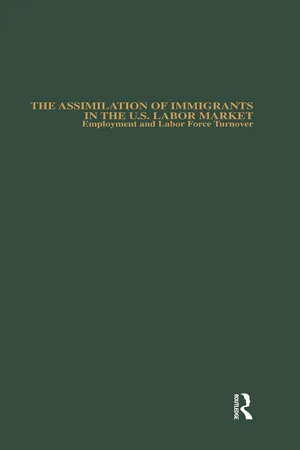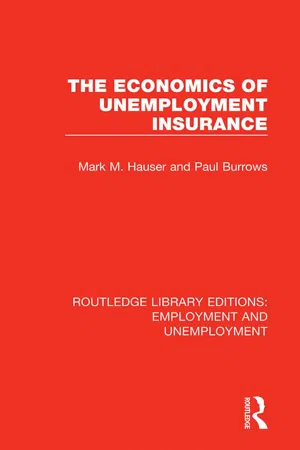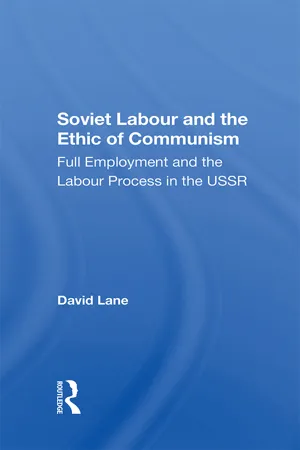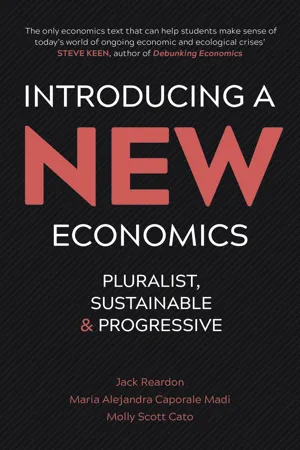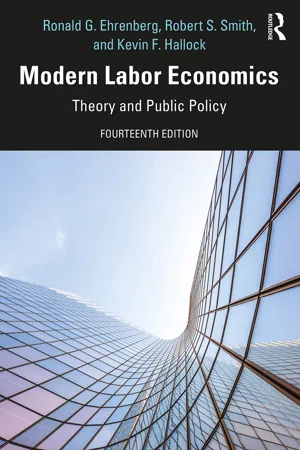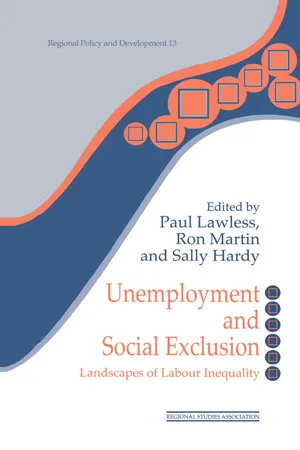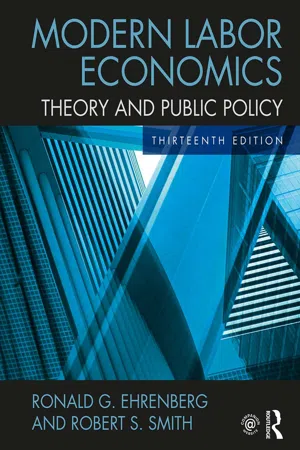Economics
Types of Unemployment
Types of unemployment include frictional, structural, cyclical, and seasonal. Frictional unemployment occurs when people are between jobs, while structural unemployment is caused by mismatches between the skills of workers and the requirements of available jobs. Cyclical unemployment is related to fluctuations in the business cycle, and seasonal unemployment occurs due to seasonal variations in demand for labor.
Written by Perlego with AI-assistance
Related key terms
Related key terms
1 of 4
Related key terms
1 of 3
10 Key excerpts on "Types of Unemployment"
- eBook - ePub
The Assimilation of Immigrants in the U.S. Labor Market
Employment and Labor Force Turnover
- Michael E. Hurst(Author)
- 2018(Publication Date)
- Routledge(Publisher)
Structural unemployment also is derived from imbalances and imperfect information and mobility, and can be thought of as a long-term form of frictional unemployment. Structural unemployment, however, occurs between sectors—if workers were perfectly mobile between occupations, industries, or geographic areas (through the ability to acquire education, for example), and if they had advance notice of impending changes in their current sector, adjustments could be made so that structural unemployment would not exist. Structural unemployment is generally long term in nature, and is often associated with plant closings and mass layoffs.Cyclical unemployment, often called demand-deficient unemployment, primarily occurs because of fluctuations in business activity and rigid wages. When aggregate demand declines, if wages are inflexible downward demand for labor declines as well. Cyclical unemployment occurs across sectors—if unemployment increased because of deficient demand within a sector, it would be considered structural. This book will test, among other effects, differential impacts of cyclical unemployment between immigrants and native-born workers.Seasonal unemployment is a form of short-term cyclical unemployment, with the difference that it occurs on a regular basis and can be reasonably anticipated. Seasonal unemployment will be important in this book primarily when considering different degrees of sensitivity to seasonal factors between foreign-born and native-born workers.3.4 Causes of Unemployment—Job Search, Rigid Wages, Disequilibria
The causes of the various Types of Unemployment have been widely debated. Already discussed is whether the causes of unemployment are from many persons experiencing frequent but short spells of unemployment, or from relatively few persons experiencing spells of long duration. Both views have merit and the answer is a matter of emphasis. Another part of the debate about the causes of unemployment focuses more directly on individual behavior of workers and firms. A large number of models have been developed that attempt to explain why there is unemployment at all, why persons will accept unemployment rather than reduced wages, and why dispersion in wages persists. There are several bodies of literature that have sprung up from these attempts, and many summaries, which often differ widely in how the models are grouped together or how they are described. It is beyond the scope of this book to address all models or to describe them in complete detail. Instead, a thumbnail sketch of the most salient features will be provided here, of the models that seem to hold the most promise for addressing immigrant unemployment. - eBook - ePub
- Mark M. Hauser, Paul Burrows(Authors)
- 2018(Publication Date)
- Routledge(Publisher)
It is possible to distinguish first cyclical or general unemployment. This type of unemployment is usually widespread and the danger is great that the workers involved in it will remain without work for a long time. The main cause of this type of unemployment is usually regarded as being too low a level of aggregate demand for goods and services in the economy. In the past there has been a tendency for this form of unemployment to appear at intervals of perhaps eight to ten years. This unemployment cycle is commonly referred to as the ‘major’ or the ‘business’ cycle.Besides this long and severe cycle of unemployment one can discern—very distinctly since the end of the second world war— a second, so-called ‘minor’ cycle of unemployment lasting perhaps four to five years. This second cycle is much less severe than the major cycle mentioned before. It has been associated with fluctuations especially in stocks and has therefore sometimes been labelled the ‘inventory’ cycle.Secondly, one may distinguish seasonal unemployment. This again is a distinct cycle of unemployment, but one which tends to recur periodically in particular periods of each year. Its main economic cause is the seasonal pattern of production in certain sectors of the economy and/or seasonal fluctuations in the demand structure in certain sectors. Agriculture, building and tourism are sectors experiencing seasonal demand or supply fluctuations and seasonal unemployment.A further form of unemployment is commonly referred to as frictional unemployment. This kind of unemployment accompanies technological progress, the reorganisation of production, and lasting shifts in the pattern of demand. Workers in particular jobs and with particular skills lose their occupation and must seek alternative employment. In a dynamic and developing economy there is need for constant change of this kind, which means that the labour force has to adapt itself to new conditions more or less continually. Thus there is a certain level of frictional unemployment at all times, though not necessarily always in the same sectors or in the same geographical areas of the economy. - eBook - ePub
Soviet Labour And The Ethic Of Communism
Full Employment And The Labour Process In The Ussr
- David Lane(Author)
- 2019(Publication Date)
- Routledge(Publisher)
4 Types of Involuntary UnemploymentWhile mass structural unemployment is not a characteristic of the USSR, one must consider the presence of other forms of unemployment and underemployment, the most important types of which are 'structural', 'seasonal' and 'frictional'. Structural unemployment is an absence of jobs in a particular labour market. This usually occurs on a regional basis. Population grows in a given area at a faster rate than the supply of jobs. In addition, certain districts might be predominantly concerned with a particular industry having a relatively narrow and specialized pattern of skills: for instance, the mining industry recruits few women workers, in textiles men are a minority and agriculture (at least in the USSR) has a preponderance of unskilled manual workers. 'Seasonal' unemployment is linked to the cyclical nature of production or of demand. In the Soviet Union, due to the inclement winter weather, this is particularly the case with agriculture, fishing, open-cast mining and building. 'Frictional' unemployment occurs when workers are idle between jobs or statuses. School-leavers or demobilized military may not wish, or may be unable, to find suitable work immediately. If workers are hierarchically or geographically mobile there may be periods of idleness between the time that workers leave one job and take up another.Frictional Unemployment
In any modern economy, however perfectly organized, there are likely to be periods of'friction' when school-leavers come onto the market or when employees voluntarily change jobs. Instantaneous individual adjustments which would be necessary to equilibriate supply of (and demand for) labour even in a perfectly free market are impossible to achieve: in any labour market there are always some jobs vacant and some people seeking work. This is illustrated in Figure 4.1 . At wage W, ONi is demanded, but only ON is employed. The frictional level of unemployment is N-Ni.1 - eBook - ePub
Introducing a New Economics
Pluralist, Sustainable and Progressive
- Jack Reardon, Maria Alejandra Caporale Madi, Molly Scott Cato(Authors)
- 2017(Publication Date)
- Pluto Press(Publisher)
Arthur Pigou in The Theory of Unemployment (1933 [1968]) for example, studied ‘frictional unemployment’ as unemployment arising from normal labour turnover from the ongoing creation and destruction of jobs and from people entering and leaving the labour force. During the Great Depression, John Maynard Keynes (1883–1946) argued that the capitalist system cannot obtain full levels of spending, income and employment; and that at any one point in time it is highly unlikely that the economy will operate at full capacity. He distinguished ‘frictional unemployment’ from ‘involuntary unemployment’; the latter ignored and assumed not to exist according to neoclassical economists, but which according to Keynes presented a fundamental social and economic problem. Simply defined, involuntary unemployment occurs when a worker wants a job but is unable to attain one, since not enough are offered. This is usual during recessions. At this juncture it is important we understand and define the different Types of Unemployment. Frictional unemployment occurs when workers switch jobs or change occupations. According to Keynes, this includes ‘various inexactnesses of adjustment. . . so that there will always exist in a non-static society a proportion of resources employed in ‘between jobs’ (Keynes, 1936 [2010]: 6). If a worker switches her job, she can either switch jobs immediately from the old to the new, or quit and search for a new one. Only the latter counts as unemployment. Voluntary unemployment occurs when workers quit their present job to look for something different, and presumably better, than their present job. A paradox here is that as the job market improves, voluntary unemployment can increase, which, all else being equal, will increase the overall unemployment rate - eBook - ePub
- George E. Rejda(Author)
- 2015(Publication Date)
- Routledge(Publisher)
The major advantage of tax credits is that employers have a strong financial incentive to hire those unemployed workers most in need of help. Tax credits are also helpful in reducing structural unemployment.On the negative side, however, tax credits have certain disadvantages. Tax credits are expensive because of reduced tax revenues to the federal government, which makes it more difficult to reduce the sizable federal deficit. In addition, tax credits alone cannot substantially reduce the total unemployment rate during economic downswings. Expansionary monetary and fiscal policies are also needed to stimulate the economy during such periods.SUMMARY
• Involuntary unemployment can cause economic insecurity because of the loss of earned income; unemployment also forces many employees to work part-time because of economic reasons; there is also uncertainty of income for workers with jobs; and some groups have considerable difficulty finding jobs.• Cyclical unemployment (also called demand-deficient unemployment) is unemployment that results from a deficiency in aggregate demand.• Technological unemployment is unemployment that results from the displacement of workers by new computer technology, labor-saving machinery, new production techniques, or new management methods.• Structural unemployment can be defined as unemployment that results from a mismatch between the skills required for the available jobs in the community and skills possessed by workers seeking work.• Frictional unemployment refers to temporary unemployment that can result from the changing of jobs.• Seasonal unemployment can result from fluctuations in business activity because of weather, customs, styles, and habits.• The Bureau of Labor Statistics (BLS) releases monthly statistics on employment, unemployment, people outside the labor force, and other personal and occupational characteristics of the working population.• - eBook - ePub
Modern Labor Economics
Theory and Public Policy
- Ronald Ehrenberg, Robert Smith, Kevin Hallock(Authors)
- 2021(Publication Date)
- Routledge(Publisher)
One reason why we might observe a negatively sloped wage curve can be found in the efficiency-wage explanation of structural unemployment reviewed earlier. Suppose, for example, that one cause of long-term unemployment is the widespread payment of above-market wages by employers in an effort to reduce shirking among their employees. In regions where this and other causes happen to create higher levels of unemployment, the efficiency-wage premiums needed to reduce shirking would be lower—which would cause the negative association that we observe between regional unemployment rates and wage levels.Demand-Deficient (Cyclical) Unemployment
Frictional unemployment arises because labor markets are dynamic and information flows are imperfect; structural unemployment arises because of long-lasting imbalances in demand and supply. Demand-deficient unemployment is associated with fluctuations in business activity (the “business cycle”), and it occurs when a decline in aggregate demand in the output market causes the aggregate demand for labor to decline in the face of downward inflexibility in real wages. Such a decline took place during the Great Recession of 2007 to 2009, during which time the unemployment rate in the United States rose from 4.4 percent in the spring of 2007 to 10 percent in the fall of 2009.35 Another sudden increase in unemployment took place from February to April in 2020, although the sudden rise in the U.S. unemployment rate from 3.5 percent to 14.7 percent was rooted in the abrupt shutdown of businesses and travel to reduce the spread of COVID-19—not the business cycle.Returning to our simple demand-and-supply model of Figure 14.2 , suppose that a temporary decline in aggregate demand leads to a shift in the labor demand curve to D1 . If real wages are inflexible downward, employment will fall to E1 , and E0 −E1 additional workers will become unemployed. This employment decline occurs when firms lay off workers (increasing Peu )36 and reduce the rate at which they replace those who quit or retire (decreasing Pne and Pue - eBook - ePub
Unemployment and Social Exclusion
Landscapes of Labour inequality and Social Exclusion
- Sally Hardy, Paul Lawless, Ron Martin(Authors)
- 2013(Publication Date)
- Routledge(Publisher)
Rubery 1992a ). In short, we do not have an active labour market policy which reacts quickly and effectively to employment loss by providing positive signals and direction. The delayed, dilatory response that typifies current policy practice follows directly from the counter-revolution and its emphasis on inflation reduction as the key economic objective. The short-term unemployed and flows into unemployment are assumed to maintain the effective labour reserve. Policies which reduce their numbers would add to inflationary pressure. Labour market policy should thus address flows out of unemployment, and particularly the long-term unemployed because they are so far removed from opportunity that a reduction in long-term unemployment will do little to add to the bargaining power (inflationary threat) of labour. The claim that we should react to those without work only when it is quite clear that loss of opportunity is lasting deserves a direct challenge. Probability of escape from unemployment certainly declines the longer people are without work. With long unemployment, skills deteriorate; the habit of regular work may be lost; the self-respect and self-confidence of the individual and the view of the potential employer change. But it is surely preferable to prevent the flows into unemployment in the first place. A policy approach which develops from the counter-revolution will be hard on the unemployed, but soft on the causes of unemployment. If one wishes to understand – rather than disguise or deny – unemployment, the counterrevolution is not the ideal philosophy.Recognising Unemployment: Regions and Structural Change
Involuntary unemployment is the product of a cumulative process which is triggered by an initial decline in key sectors of the local economy. Modern unemployment takes its characteristic form from the employment relationship within large industrial units. Such employment requires a clear separation between the formal and the informal economy: a clear divide between organised and casual work. When this form of secure employment disappears, a gap or space emerges within the community and around the individual. That gap or space is the essence of unemployment (see Piore 1987 ). It cannot simply be assumed that work is always available to those who are truly flexible; to bridge the gap may require a collective response as well as individual initiative. Experience in work does not necessarily translate into alternative productive activity and without capital, without organisation, the individual and the community lack direction. The unemployment which follows major plant closures and cutbacks is not indicative of a sudden taste for leisure on the part of the workers involved. Neither can it be explained in terms of productive job search.The internal labour market literature (see Doeringer and Piore 1985 - eBook - ePub
The Industrial System (Routledge Revivals)
An Inquiry into Earned and Unearned Income
- J. Hobson(Author)
- 2013(Publication Date)
- Routledge(Publisher)
Chapter XVIII Unemployment1. Cyclical unemployment cannot be attributed to failure of wheat harvests, for (1) statistics show no correspondence between changes in world production of wheat and fluctuation of employment, (2) the effect of a shortage of wheat upon the aggregate employment could not be large. A simultaneous shortage of several important raw materials may appreciably affect employment, but statistical evidence does not indicate such shortage as a chief cause of cyclical unemployment.2. Machinery or other improvements in an industry may cause an increase or decrease of employment in that trade or related trades, according to ‘elasticity of demand,’ but cannot account at any given time for any large proportion of displacement.3. For the main cause of unemployment we must look to the action of the ‘unproductive surplus’ in stimulating automatic saving at a higher rate than is needed and can be used to assist in making provision against future consumption. Economic checks on over-saving only operate where much mischief is done. The unemployed problem is that of the existence of a simultaneous excess of all factors of production.4. Analysis of the course of actual depressions confirms this interpretation. The psychological or ‘credit’ explanation turns ultimately on the known inability of business men to dispose of goods at profitable prices, i.e. the failure of consumption to keep pace with power of production.5. The existence and amount of over-saving is concealed by the mechanism of investment. In depressed trade over-savings need not stand in a growing pool of idle capital: their owners may invest them, not in setting up new capital forms, but in acquiring property from impoverished owners.6. This analysis furnishes a test of the efficacy of all remedies or palliatives of unemployment. The validity of remedies depends upon their power to stimulate consumption by increasing the proportion of spending power vested in the workers or in public bodies - eBook - ePub
Modern Labor Economics
Theory and Public Policy
- Ronald G. Ehrenberg, Robert S. Smith(Authors)
- 2017(Publication Date)
- Routledge(Publisher)
and if costs of occupational or geographic mobility were low, market adjustments would quickly eliminate this type of unemployment. In practice, however, these conditions may fail to hold, and structural unemployment may result.Occupational and Regional Unemployment Rate Differences
A two-sector labor market model, represented by Figure 14.5 , can be used to illustrate how structural unemployment can arise. For the moment, we shall assume the sectors refer to markets for occupational classes of workers; later, we shall assume that they are two geographically separate labor markets.Occupational Imbalances Suppose that market A is the market for production workers in the automobile industry and market B is the market for skilled computer specialists, and suppose that initially both markets are in equilibrium. Given the demand and supply curves in both markets, (D 0 A , S 0 A ) and (D 0 B , S 0 B ), the equilibrium wage/employment combinations in the two sectors will be (W 0 A , E 0 A ) and (W 0 B , E 0 B ), respectively. Because of differences in training costs and nonpecuniary conditions of employment, the wages need not be equal in the two sectors.Figure 14.5 Structural Unemployment Due to Inflexible Wages and Costs of AdjustmentNow, suppose that the demand for automobile workers falls to D 1 A as a result of foreign import competition, while the demand for computer specialists rises to D 1 B as a result of the increased use of computers. If real wages are inflexible downward in market A because of union contract provisions, social norms, or government legislation, employment of automobile workers will fall to E 1 A . Employment and wages of computer specialists will rise to E 1 B and W 1 B , respectively. Unemployment of E 0 A – E 1 A - eBook - ePub
- William H. Beveridge(Author)
- 2014(Publication Date)
- Routledge(Publisher)
143. For the period between the two World Wars, there is a full record of severe unemployment in Britain and there are records which leave little doubt that during the nineteen-thirties unemployment was substantially more serious in the United States than in Britain, to compensate for its lesser seriousness before 1930. In this period each country experienced a particularly severe return of cyclical fluctuation; though more violent in Britain than anything experienced, at least since 1850, this fluctuation was of the same general character as former fluctuations—was a fresh manifestation of the international trade cycle. The boom which ended this fluctuation in 1937 and heralded the beginning of a new depression, left 10 per cent of the labour force unemployed in Britain and about 12 per cent unemployed in the United States. As regards the United States, this high unemployment at the top of a cyclical boom cannot be explained as due to structural unemployment. If that explanation is offered for Britain, the answer is that failure for nearly twenty years to deal with structural unemployment is in itself a serious weakness of the unplanned market economy. Because such demand as was generated by this economy for the products of industry was so weak, it was not effective in overcoming industrial friction; because it was so badly located with reference to the supplies of available labour, it made that friction abnormally strong.144. The need for a new attack on the problem of unemployment cannot be denied to-day, except in a mood of unthinking optimism. The attack must be on three lines. There is unemployment due to chronic or recurrent deficiency of demand. There is unemployment due to mis-direction of demand. There is unemployment due to the degree to which the labour market remains unorganized and to the manner in which particular industries respond to demand. The reduction of unemployment to a harmless minimum requires, therefore, measures of three kinds; measures to ensure sufficient steady demand for the products of industry; measures to direct demand with regard to the labour available; measures to organize the labour market and to assist the supply of labour to move in accord with demand.1 See para. A 42 in Appendix A .1 Memoranda on British and Foreign Trade and Industry (Second Series), 1904 (Cd. 2337).2
Index pages curate the most relevant extracts from our library of academic textbooks. They’ve been created using an in-house natural language model (NLM), each adding context and meaning to key research topics.
Explore more topic indexes
Explore more topic indexes
1 of 6
Explore more topic indexes
1 of 4
